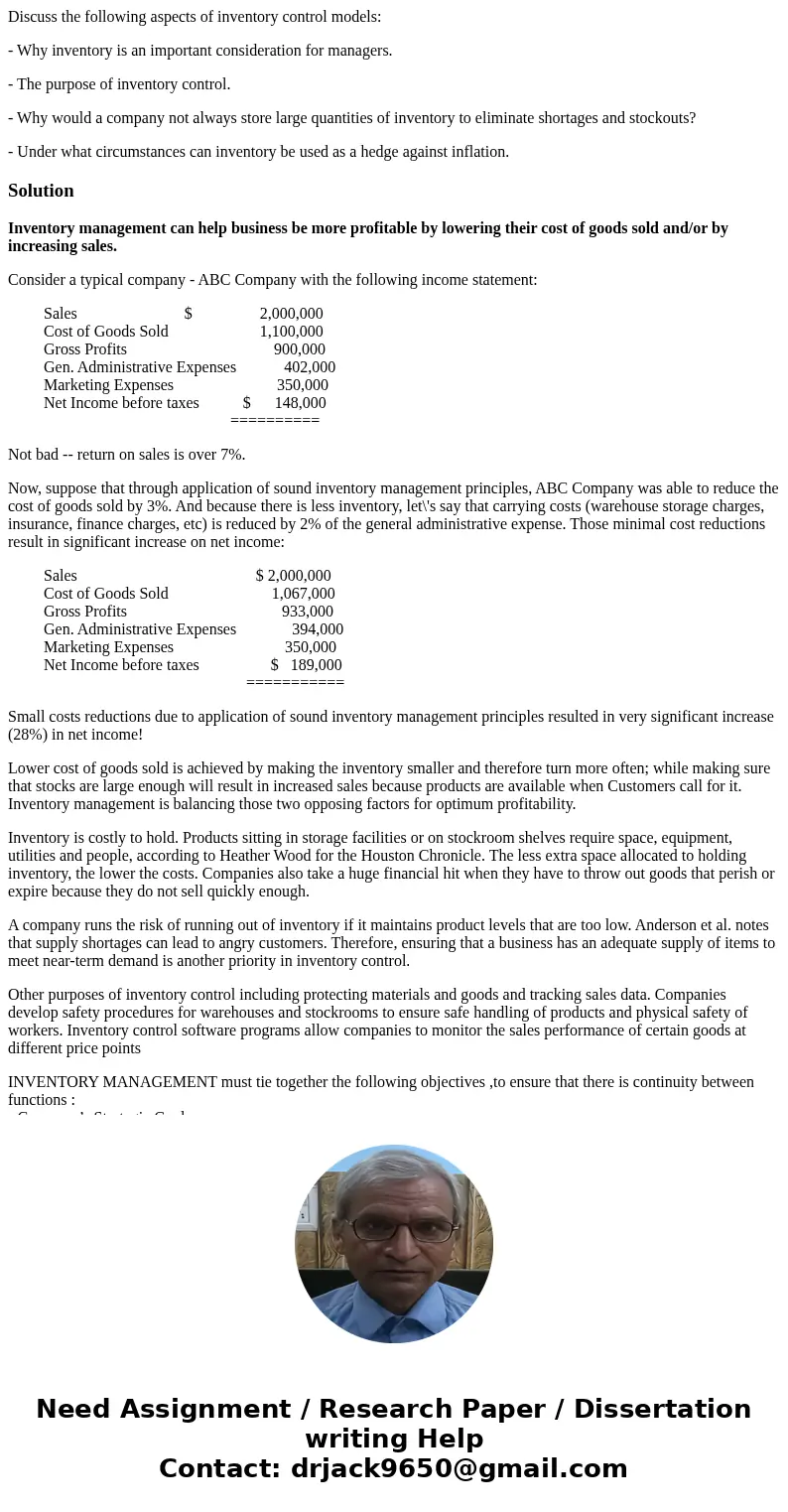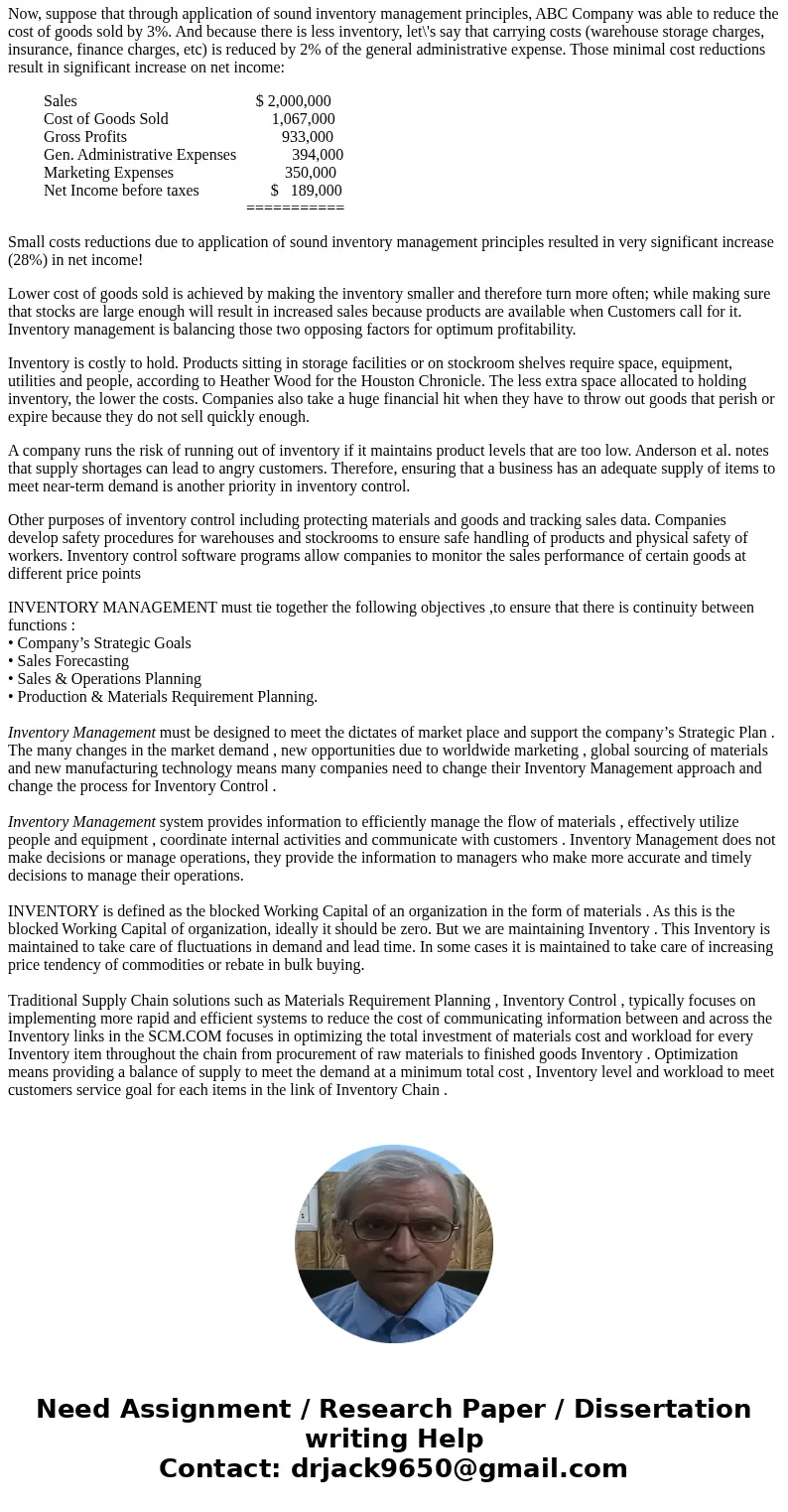Discuss the following aspects of inventory control models W
Discuss the following aspects of inventory control models:
- Why inventory is an important consideration for managers.
- The purpose of inventory control.
- Why would a company not always store large quantities of inventory to eliminate shortages and stockouts?
- Under what circumstances can inventory be used as a hedge against inflation.
Solution
Inventory management can help business be more profitable by lowering their cost of goods sold and/or by increasing sales.
Consider a typical company - ABC Company with the following income statement:
Sales $ 2,000,000
Cost of Goods Sold 1,100,000
Gross Profits 900,000
Gen. Administrative Expenses 402,000
Marketing Expenses 350,000
Net Income before taxes $ 148,000
==========
Not bad -- return on sales is over 7%.
Now, suppose that through application of sound inventory management principles, ABC Company was able to reduce the cost of goods sold by 3%. And because there is less inventory, let\'s say that carrying costs (warehouse storage charges, insurance, finance charges, etc) is reduced by 2% of the general administrative expense. Those minimal cost reductions result in significant increase on net income:
Sales $ 2,000,000
Cost of Goods Sold 1,067,000
Gross Profits 933,000
Gen. Administrative Expenses 394,000
Marketing Expenses 350,000
Net Income before taxes $ 189,000
===========
Small costs reductions due to application of sound inventory management principles resulted in very significant increase (28%) in net income!
Lower cost of goods sold is achieved by making the inventory smaller and therefore turn more often; while making sure that stocks are large enough will result in increased sales because products are available when Customers call for it. Inventory management is balancing those two opposing factors for optimum profitability.
Inventory is costly to hold. Products sitting in storage facilities or on stockroom shelves require space, equipment, utilities and people, according to Heather Wood for the Houston Chronicle. The less extra space allocated to holding inventory, the lower the costs. Companies also take a huge financial hit when they have to throw out goods that perish or expire because they do not sell quickly enough.
A company runs the risk of running out of inventory if it maintains product levels that are too low. Anderson et al. notes that supply shortages can lead to angry customers. Therefore, ensuring that a business has an adequate supply of items to meet near-term demand is another priority in inventory control.
Other purposes of inventory control including protecting materials and goods and tracking sales data. Companies develop safety procedures for warehouses and stockrooms to ensure safe handling of products and physical safety of workers. Inventory control software programs allow companies to monitor the sales performance of certain goods at different price points
INVENTORY MANAGEMENT must tie together the following objectives ,to ensure that there is continuity between functions :
• Company’s Strategic Goals
• Sales Forecasting
• Sales & Operations Planning
• Production & Materials Requirement Planning.
Inventory Management must be designed to meet the dictates of market place and support the company’s Strategic Plan . The many changes in the market demand , new opportunities due to worldwide marketing , global sourcing of materials and new manufacturing technology means many companies need to change their Inventory Management approach and change the process for Inventory Control .
Inventory Management system provides information to efficiently manage the flow of materials , effectively utilize people and equipment , coordinate internal activities and communicate with customers . Inventory Management does not make decisions or manage operations, they provide the information to managers who make more accurate and timely decisions to manage their operations.
INVENTORY is defined as the blocked Working Capital of an organization in the form of materials . As this is the blocked Working Capital of organization, ideally it should be zero. But we are maintaining Inventory . This Inventory is maintained to take care of fluctuations in demand and lead time. In some cases it is maintained to take care of increasing price tendency of commodities or rebate in bulk buying.
Traditional Supply Chain solutions such as Materials Requirement Planning , Inventory Control , typically focuses on implementing more rapid and efficient systems to reduce the cost of communicating information between and across the Inventory links in the SCM.COM focuses in optimizing the total investment of materials cost and workload for every Inventory item throughout the chain from procurement of raw materials to finished goods Inventory . Optimization means providing a balance of supply to meet the demand at a minimum total cost , Inventory level and workload to meet customers service goal for each items in the link of Inventory Chain .


 Homework Sourse
Homework Sourse